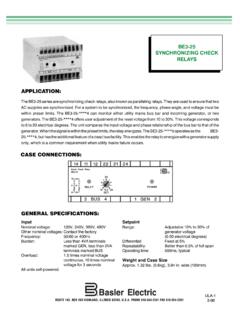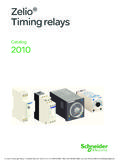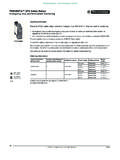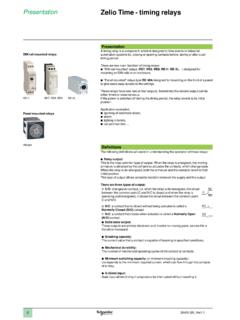Transcription of Latching, Sequence and Impulse Relays – Application Data
1 SECTION 7 Magnecraft Solution Guide 105 AMagnecraft Solution Guide 105A755785711303 Series385 latching , Sequence and Impulse Relays Application DataEnergy Conservation RelaysIn many applications it is important for the customer to conserve electrical energy. One approach to energy conservation in an electrical system is to use Relays that do not require constant power to maintain contact closure. latching relay is a generic term that is used to describe a relay that maintains its contact position after the control power has been removed. latching Relays allow a customer to control a circuit by simply providing a single pulse to the relay control circuit.
2 latching Relays are also desirable when the customer needs to have a relay that maintains its position during an interruption of power. There are three main types of latching Relays . Magnetic latching , Mechanical latching and Impulse latching RelaysMagnetic latching Relays require one pulse of coil power to move their contacts in one direction, and another, redirected pulse to move them back. Repeated pulses from the same input have no effect. Magnetic latching Relays are useful in applications where interrupted power should not be able to transition the latching Relays can have either single or dual coils. On a single coil device, the relay will operate in one direction when power is applied with one polarity, and will reset when the polarity is reversed.
3 On a dual coil device, when polarized voltage is applied to the reset coil the contacts will transition. AC controlled magnetic latch Relays have single coils that employ steering diodes to differentiate between operate and reset commands. Mechanical latching RelaysMechanical latching Relays use a locking mechanism to hold their contacts in their last set position until commanded to change state, usually by means of energizing a second coil. Since the relay does not rely on a magnet, the locking strength will not degrade over time or weaken during thermal cycling. The contacts will remain locked in the directed position until the opposing coil has been energized.
4 Packaging machinery that places several units into a single container would be a good RelaysImpulse Relays are a form of latching relay that transfers the contacts with each pulse. Many Impulse Relays are made up of a magnetic latch relay and a solid state steering circuit that, upon Application of power, determines which position the relay is in and energizes the opposite coil. The contacts transfer and hold that position when power is removed. When reenergized, the contacts transfer again and hold that position, and so on. In order to transfer the contacts, one simply provides a single unidirectional pulse. There is no need to redirect the control pulse or reverse the Relays can be used as wear equalizers.
5 They are well suited for applications such as turning a single device on or off from one or more locations with a single momentary switch or push button at each station. For example, a conveyor could be started and/or stopped from multiple locations by means of a single button at each Solution Guide 105 ASECTION 7 Magnecraft Solution Guide 847-441-2540 Alternating Relay Application DataApplications:712 Alternating RelayIn many industrial pumping applications , two identical pumps are used for the same job. A standby unit is available in case the first pump fails. However, a completely idle pump might deteriorate and provide no safety margin.
6 Alternating Relays prevent this by assuring that both pumps get equal run Model 712 Series Alternating Relay is designed for duplex pumping systems where it is desirable to equalize pump run time. The solid state alternating circuit drives an internal electromechanical relay. A continuous power source and control switch is control switch (float, pressure or other isolated contact) is connected as shown in the respective wiring diagrams. Each time the control switch is opened the output contacts will change status. Indicator lights on the case show the internal relay status. Setting the top toggle switch to the center position alternates the load; while setting the switch to Load 1 or Load 2 will lock the relay in the respected position, preventing alternation.
7 The alternating relay approach isn t limited to pumping applications . The control switches could be thermostats or pressure switches, and the loads could be fans or 7 Magnecraft Solution Guide 105 AMagnecraft Solution Guide 105 ASingle Coil (DC)Single Coil (AC)Dual Coil (DC)AA1711144121BA2921246223 RESETOPERATEAA1711144121BA29212462238B2 OPERATERESETCOMMONAA1711144121BA29212462 238B2B15 RESETOPERATECOIL2 COIL ( ) ( ) ( ) ( ) QUICK CONNECTS785 Magnetic latching Square Base Relay/DPDT, 16 Amp RatingSingle and Dual (DC only) coil Amp switching capabilitiesHigh strength magnetic latch helps contacts hold during .1875 blade style socket DIAGRAMSU nitsAVResistiveResistiveResistiveHPHPP ilot DutymAVVVAW(Resistive)msV(rms)V(rms)V(rm s) C Cg-ng-ngramsStandardDPDTS ilver Alloy1630016A @ 277V 50/60Hz16A @ 120V 50/60Hz16A @ 28V 1/3 @ 120 VAC1/2 @ 240 VACB300100 @ 5 VDC (.)
8 5W) , 50/60 to 110%80% to 110% ,0005,000,00020150015001500UL, CSA, + +553, 10 - 55 Hz10IP 4087% of NominalOperations @ Rated CurrentUnpoweredBetween coil and contactBetween polesBetween contactsStandard versionStorageOperationOperationalContac t Characteristics Number and type of ContactsContact materialsThermal (Carrying) CurrentMaximum Switching VoltageSwitching Current @ VoltageMinimum Switching RequirementCoil CharacteristicsVoltage RangeOperating Range Average consumptionDrop-out voltage thresholdPerformance CharacteristicsElectrical Life (UL508)Mechanical LifeOperating time (response time)Dielectric strengthEnvironmentProduct certificationsAmbient air temperaturearound the deviceVibration resistanceShock resistanceDegree of protectionWeightGeneral Specifications (UL 508)~~~~~~~~~785 XBXWHITEUL RecognizedFile No.
9 E43641 ULUSCUL Listed When Used With Magnecraft Solution Guide 105 ASECTION 7 Magnecraft Solution Guide 105 AOther mating sockets see Section 2: 70-788EL11-1, 70-124-1, 70-124-2, 70-178-1, 70-178-2 Part Number Builder(63)(92)(96) (74)BOLD-FACED PART NUMBERS ARE NORMALLY 847-441-2540785 Series785 XBXC ontact ConfigurationDPDT = XBXCCoil OptionsSingle Coil = CDouble Coil = CD 240 ACoil VoltageVAC = 6 - 240 AVDC = 6 - 125 DCoil Resistance32 Ohms120 Ohms470 Ohms10,000 Ohms40,000 Ohms22/22 Ohms88/88 Ohms350/350 Ohms1,400/1,400 Ohms9,000/9,000 Ohms120 Ohms470 Ohms10,000 OhmsPart Number785 XBXC-6A785 XBXC-12A785 XBXC-24A785 XBXC-120A785 XBXC-240A785 XBXCD-6D785 XBXCD-12D785 XBXCD-24D785 XBXCD-48D785 XBXCD-110D785 XBXC-12D785 XBXC-24D785 XBXC-125 DNominal VoltageAC Operated (Single Coil)
10 6 VAC 50/60 HZ12 VAC 50/60 HZ24 VAC 50/60 HZ120 VAC 50/60 HZ240 VAC 50/60 HZDC Operated (Dual Coil)6 VDC12 VDC24 VDC48 VDC110/125 VDCDC Operated (Single Coil)12 VDC24 VDC110/125 VDCS tandard Part Numbers70-788EL11-1 SOCKETThe 785 Magnetic latching relay, with an Industry Standard square base, operates by using a pulsed input. A permanent magnet maintains the last position until a redirected second pulse moves the contacts back to the original






